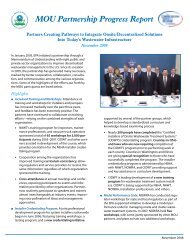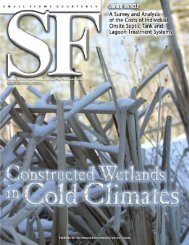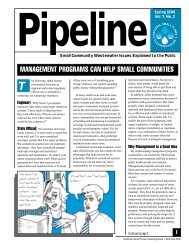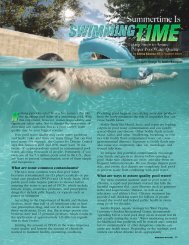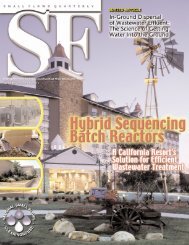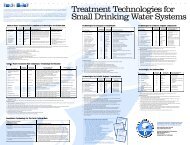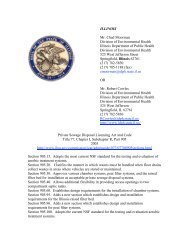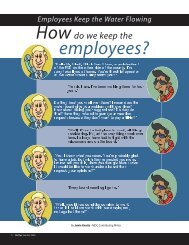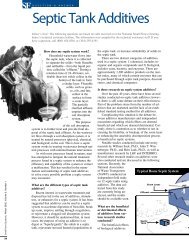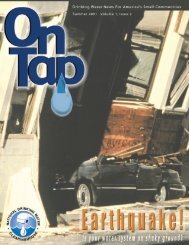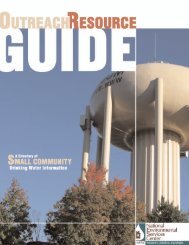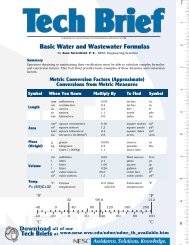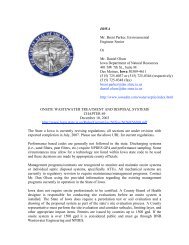Craig Mains | Technical Assistant - National Environmental Services ...
Craig Mains | Technical Assistant - National Environmental Services ...
Craig Mains | Technical Assistant - National Environmental Services ...
Create successful ePaper yourself
Turn your PDF publications into a flip-book with our unique Google optimized e-Paper software.
And this not only applies to terrorism;<br />
it may also be necessary<br />
with natural disasters, such as the<br />
Iowa floods. “A small utility might<br />
not have the recruitment to handle<br />
physical damage to their system,”<br />
Morley observes. “Like when a hurricane<br />
occurs, a utility might not<br />
have the capacity of its own crews<br />
to handle the emergency, so they<br />
bring in workers from other utilities<br />
to help re-establish service. They<br />
can get the system stabilized in<br />
quick order and leave out all the<br />
mumbo jumbo legal stuff. You don’t<br />
want to deal with that when the<br />
crap is hitting the fan.<br />
“In the Des Moines and Cedar<br />
Rapid floods, major parts of the<br />
city had to be evacuated,” he continues.<br />
“If you can bring in workers<br />
from another utility from an unaffected<br />
part of the state, that allows<br />
your employees to deal with the<br />
things they need to deal with.<br />
That’s a huge benefit.”<br />
The WARN Identity<br />
Although 37 states are now<br />
identified as WARN states, much<br />
work remains to be done. “We’ve<br />
paid for the car, now we’ve got to<br />
do driver’s education,” Morely says.<br />
“A lot of it comes down to communications<br />
and understanding. How do<br />
we ask for and respond to each<br />
other with a request efficiently? It really<br />
is a partnership. We need to understand<br />
how we work with each<br />
other.”<br />
One method of ironing out the<br />
kinks of the program is to implement<br />
a universal supply list. Morley said<br />
enacting the WARN agreements sufficiently<br />
will require all utilities to use<br />
the same language. “Each utility has<br />
a different level of sophistication,” he<br />
says. “At its basic form, communication<br />
is the optimal way a request<br />
should go out. For example, say one<br />
utility asks another utility for a telephone.<br />
The question is, are you looking<br />
for a punch-button telephone or a<br />
rotary? You need to be specific in<br />
what you’re asking for.”<br />
To address this issue, AWWA is<br />
in the process of developing a resource<br />
manual to establish a common<br />
request list that identifies and<br />
sets parameters on resources to<br />
eliminate a lot of back and forth communication<br />
between utilities in a time<br />
of crisis.<br />
Growth Rate<br />
The WARN program has grown<br />
at a rate that was unanticipated and<br />
is adding members monthly, according<br />
to Morley. “We had no preconceived<br />
notion of how many states<br />
and utilities would recognize the<br />
value of this. We thought for sure we<br />
could get the Gulf Coast states,<br />
which have been hammered by hurricanes,”<br />
he explains. “We knew<br />
those folks would see the value in<br />
the program, but we didn’t anticipate<br />
states like South Dakota and North<br />
Dakota readily recognizing that they<br />
have needs like this too. There is no<br />
state in the union that is immune<br />
from natural disaster. Even taking<br />
terrorism off the table, nine times out<br />
of 10, utilities will be dealing with<br />
mother nature.”<br />
Morley said the water industry’s<br />
ability to respond to a disaster has<br />
been greatly improved due to the<br />
WARN program. “I think we have<br />
significantly enhanced the water<br />
sector’s capability to respond to an<br />
incident. Do I think it’s complete?<br />
Absolutely not. There is still a lot of<br />
work to be done,” he says. “In these<br />
difficult economic conditions, it’s<br />
even more important for utilities to<br />
be part of a WARN. They are in a resource-strained<br />
environment. Whatever<br />
you can do to maximize resiliency,<br />
the better off you will be.”<br />
More Information<br />
To learn more about WARNs,<br />
visit the AWWA WARN Web site at<br />
www.nationalwarn.org. AWWA has a<br />
sample WARN agreement on its<br />
Web site at www.awwa.org/<br />
Government/Content.cfm?ItemNumber=3837.<br />
The guide “Utilities Helping Utilities:<br />
An Action Plan for Mutual Aid<br />
and Assistance Networks,” may be<br />
accessed at www.awwa.org/files/<br />
Advocacy/Govtaff/Documents/Utilities_Helping_Utilities.pdf.<br />
To help publicize WARNs, EPA<br />
has created a three-panel poster<br />
that can be downloaded from<br />
www.epa.gov/safewater/watersecurity/pubs/poster_warn.pdf.<br />
27




